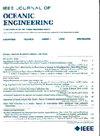A Novel Tracker of Adaptive Directional Ridge Separation and Prediction for Detecting Whistles
IF 3.8
2区 工程技术
Q1 ENGINEERING, CIVIL
引用次数: 0
Abstract
Whistle detection of marine mammal signals with close and overlapping components of varying amplitudes is a key task for overlapping source separation. In this article, we propose a novel tracker, called adaptive directional ridge separation and prediction, for detecting whistles, which are typically analyzed using a time-frequency (TF) representation. Inspired by TF reassignment, a new reassignment scheme based on time-scale changes is developed to acquire instantaneous TF points with high energy concentration. To address the mutual interference among various types of components, a tone-pulse separation model is introduced for the aliased TF components, utilizing these instantaneous TF points and instantaneous rotating operators. An adaptive directional ridge predictor is established for application in automatic overlapping whistle detection, ensuring unbroken detection even when a whistle becomes nearly indistinguishable in the TF representation. Experimental results, obtained using both a simulated signal and recorded calls of marine mammals, demonstrate the superiority of the proposed method compared to other state-of-the-art methods. This method is capable of performing whistle detection and separating overlapping sources even in the presence of splash noises, which may cause partial distortion or disconnection of components from the TF representation.一种新型自适应定向脊分离与预报跟踪器用于哨声检测
海洋哺乳动物信号的哨音检测是重叠源分离的关键任务之一。在本文中,我们提出了一种新的跟踪器,称为自适应定向脊分离和预测,用于检测口哨,通常使用时频(TF)表示进行分析。在能量重分配的启发下,提出了一种基于时间尺度变化的能量重分配方案。为了解决不同类型的分量之间的相互干扰,利用这些瞬时TF点和瞬时旋转算子,引入了混叠TF分量的音脉冲分离模型。建立了一种自适应方向脊预测器,用于自动重叠哨子检测,即使哨子在TF表示中几乎无法区分,也能确保不间断检测。利用模拟信号和海洋哺乳动物的录音呼叫获得的实验结果表明,与其他最先进的方法相比,所提出的方法具有优越性。这种方法能够执行哨音检测和分离重叠源,即使在存在飞溅噪声的情况下,这可能导致部分失真或从TF表示的组件断开。
本文章由计算机程序翻译,如有差异,请以英文原文为准。
求助全文
约1分钟内获得全文
求助全文
来源期刊

IEEE Journal of Oceanic Engineering
工程技术-工程:大洋
CiteScore
9.60
自引率
12.20%
发文量
86
审稿时长
12 months
期刊介绍:
The IEEE Journal of Oceanic Engineering (ISSN 0364-9059) is the online-only quarterly publication of the IEEE Oceanic Engineering Society (IEEE OES). The scope of the Journal is the field of interest of the IEEE OES, which encompasses all aspects of science, engineering, and technology that address research, development, and operations pertaining to all bodies of water. This includes the creation of new capabilities and technologies from concept design through prototypes, testing, and operational systems to sense, explore, understand, develop, use, and responsibly manage natural resources.
 求助内容:
求助内容: 应助结果提醒方式:
应助结果提醒方式:


